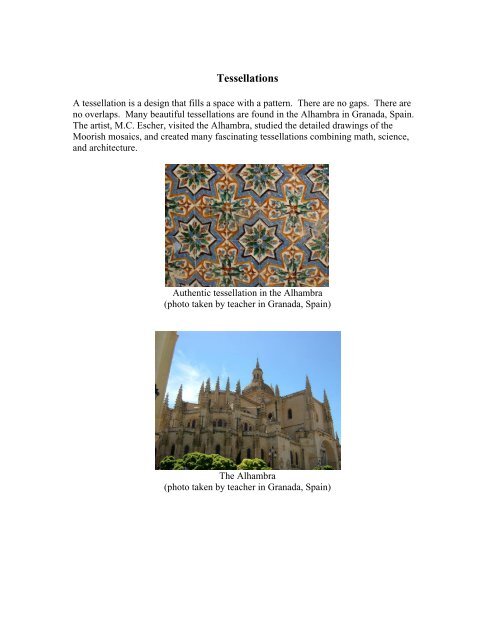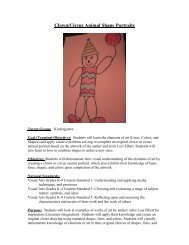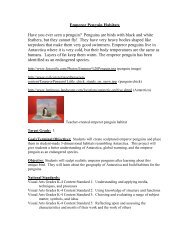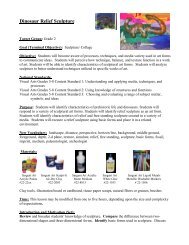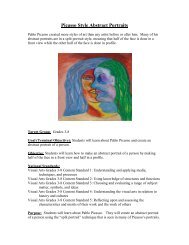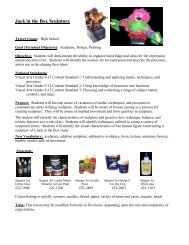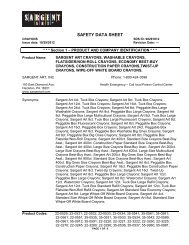Tessellations - Sargent Art
Tessellations - Sargent Art
Tessellations - Sargent Art
Create successful ePaper yourself
Turn your PDF publications into a flip-book with our unique Google optimized e-Paper software.
<strong>Tessellations</strong><br />
A tessellation is a design that fills a space with a pattern. There are no gaps. There are<br />
no overlaps. Many beautiful tessellations are found in the Alhambra in Granada, Spain.<br />
The artist, M.C. Escher, visited the Alhambra, studied the detailed drawings of the<br />
Moorish mosaics, and created many fascinating tessellations combining math, science,<br />
and architecture.<br />
Authentic tessellation in the Alhambra<br />
(photo taken by teacher in Granada, Spain)<br />
The Alhambra<br />
(photo taken by teacher in Granada, Spain)
Teacher-created example of a tessellation drawing<br />
Target Group: K-4<br />
Goal (Terminal Objective): Students will create art works that are made from their<br />
original tessellation templates. These artworks will show students’ understanding of an<br />
art form that was created in the 14 th century in Spain.<br />
Objective: Students will make original tessellation templates and develop detailed<br />
drawings from them using their acquired knowledge of the art form. They will<br />
incorporate ideas from the Alhambra in Granada, Spain, and from the Dutch artist, M.C.<br />
Escher.<br />
National Standards:<br />
Visual <strong>Art</strong>s Grades K-4 Content Standard 1: Understanding and applying media,<br />
techniques, and processes<br />
Visual <strong>Art</strong>s Grades K-4 Content Standard 2: Using knowledge of structure and functions<br />
Visual <strong>Art</strong>s Grades K-4 Content Standard 3: Choosing and evaluating a range of subject<br />
matter, symbols, and ideas<br />
Visual <strong>Art</strong>s Grades K-4 Content Standard 4: Understanding the visual art in relation to<br />
history and culture<br />
Visual <strong>Art</strong>s Grades K-4 Content Standard 5: Reflecting upon and assessing the<br />
characteristics and merits of their work and the work of others<br />
Purpose: Students will focus on the elements of design. They will create alluring art<br />
works using repetition of shape and color. They will learn about the art created in the<br />
Alhambra during the 14 th century. The art of M.C. Escher, who studied tessellations in<br />
the Alhambra, will be introduced and his tessellations will be compared to those found in<br />
the Alhambra.<br />
New Vocabulary: Alhambra, tessellation, M.C. Escher, Spain, Netherlands
Materials:<br />
22-1530 <strong>Sargent</strong> <strong>Art</strong> 22-7224 <strong>Sargent</strong> <strong>Art</strong><br />
Broad Tip Markers<br />
Colored Pencils<br />
Heavy gray construction paper, pencils, 3” x 3” index cards, permanent markers, scissors,<br />
tape<br />
Time: 3 lessons (45 minutes each)<br />
Introduction and Motivation (Set):<br />
1. Teacher introduces students to tessellations found in the Alhambra in Spain. A<br />
brief history is given.<br />
2. Where is Spain? Students look at a world map to see the distance between Spain<br />
and the United States. Have you been to Spain? Where is Granada? What<br />
countries are near Spain?<br />
3. Students view tessellations found in the Alhambra and discuss how they were<br />
made. What designs are common? How old are these tessellations?<br />
4. Teacher introduces the tessellations of M.C. Escher. What did he learn from<br />
visiting the Alhambra? Have you seen Escher’s tessellations in newspapers and<br />
other advertising?<br />
5. Teacher introduces new vocabulary.<br />
6. Teacher asks students to think about creating an all-over design using repetition of<br />
pattern and color.<br />
Instruction:<br />
Lesson 1:<br />
Teacher demonstrates making a tessellation shape from a 3” x 3” index card.<br />
Draw two shapes within the square (one at the top and one at the left corner). Cut out the<br />
shapes. Slide the top shape to the bottom of the square and tape. Slide the left shape to<br />
the right side of the square and tape. Mark the tessellation with an X.
Lesson 1
Lesson 2<br />
Following a teacher demonstration, students trace their shapes lightly onto 12” x 12”<br />
heavy gray paper. Begin in the middle of the paper and be sure to trace with the X<br />
showing. Fill in the entire paper. Younger students can then outline with permanent<br />
marker and color in the shapes, alternating colors. Older students will add detail to each<br />
tessellation shape with pencil, making sure that the design in each shape is identical.<br />
Detail can be added free hand. Outline with permanent black marker.<br />
Lesson 2<br />
Lesson 3:<br />
Teacher demonstrates outlining the tessellation shapes with colorful markers and then<br />
filling in with colored pencils. Some students may choose to allow some of the gray<br />
paper to remain uncolored. Teacher reviews color choices and repetition of color to<br />
create a balanced design.<br />
Lesson 3
Activities:<br />
(1) Guided Practice:<br />
A. Students learn about the art of designing tessellations. Students watch<br />
teacher’s step-by-step demonstrations and discuss teacher exemplars.<br />
B. Students design an original tessellation drawing using <strong>Sargent</strong> <strong>Art</strong> markers<br />
and colored pencils.<br />
(2) Independent Practice and Check for Understanding:<br />
A. Teacher circulates through the room during student work time, answering<br />
questions and offering support as needed.<br />
B. Teacher notes students’ understanding of directions and reviews with the class<br />
if necessary.<br />
(3) Closure:<br />
A. Teacher helps students mount their tessellations on 15” x 15” white tag board.<br />
The tessellations are exhibited and students take time to evaluate their work<br />
and look at the work of classmates.<br />
B. Students discuss the importance of respect for individuality.<br />
Evaluation:<br />
Level One -- The art work conveys good knowledge of tessellations and includes many<br />
design elements. The finished drawing is detailed with repetition of color and pattern.<br />
Craftsmanship is excellent. Student handles materials with confidence. The design shows<br />
a high degree of originality.<br />
Level Two – The art work conveys knowledge of tessellations and includes design<br />
elements. The finished drawing is detailed with some repetition of color and pattern.<br />
Craftsmanship is good. Student handles materials with confidence. The design<br />
is original.<br />
Level Three -- The student has made an effort to convey some knowledge of tessellation<br />
art. Some design elements are evident. The finished drawing lacks detail and repetition<br />
of color and pattern. Craftsmanship is fair. The design is original.<br />
Level Four -- The artwork does not convey knowledge of tessellation art. Design<br />
elements are not evident. The finished drawing lacks detail and repetition of color and<br />
pattern. Craftsmanship is poor. The student needs much support throughout the project.<br />
The design lacks originality.
Extension: Teacher makes copies of M.C. Escher’s designs found in the M.C. Escher<br />
Coloring Book, by Abrams. Younger children love to color and these designs are<br />
interesting for K-4. They encourage good hand-eye coordination. This is a great book to<br />
add to an art library.<br />
Resources:<br />
http://en.wikipedia.org/wiki/tessellation<br />
http://www.tessellations.org/tess-beginnings.htm<br />
http://www.tessellations.org/tess-escher9.htm<br />
http://www.gvsu.edu/math/students/adk/history.html<br />
http://educ.queensu.ca/~fmc/november2001/TessIntro.htm<br />
http://users.erols.com/ziring/escher_bio.htm<br />
BY MARY BORTZ<br />
<strong>Art</strong> Consultant<br />
_____________________________________________________________________________<br />
www.sargentart.com 09/27/2007


